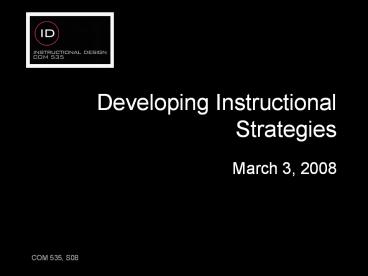Developing Instructional Strategies - PowerPoint PPT Presentation
1 / 13
Title:
Developing Instructional Strategies
Description:
Considering Components for Different Learning Domains Intellectual Skills Present subskills first. Provide links between new and old info. – PowerPoint PPT presentation
Number of Views:251
Avg rating:3.0/5.0
Title: Developing Instructional Strategies
1
Developing Instructional Strategies
- March 3, 2008
2
Two Types of Instructional Strategies
- Macro strategies
- Includes all components of instruction
- Considers best methods to convey information and
help students learn - Depends (as always) on context
- Micro Strategies
- Textbooks
- Lectures
- Case studies
- Group activities
- Exams
- Projects
- Outside media (videos, audio, etc.)
3
Identifying Learning Components
- Preinstructional activities
- Content presentation
- Learner participation
- Assessment
- Follow-through activities
4
1. Preinstructional Activities
- Motivating Learners ARCS Model
- Attention
- Relevance
- Confidence
- Satisfaction
- Explaining Objectives
- Explaining Prerequisite Skills
5
2. Content Presentation
- Identify what needs to be presented (and what can
be omitted). - Information
- Concepts
- Rules
- Principles
- Identify what kinds of examples will help
illustrate these concepts. - Good examples
- Relevant to learners
- Nonexamples
- Deliberately wrong example
6
3. Learner Participation
- Opportunity for learners to
- Practice skills
- Apply knowledge/rules
- Receive feedback
7
4. Assessment
- Consider what assessment methods will be used
during instruction. - Entry behaviors test
- Pretest
- Practice test
- Posttest
- Determine at what point these assessments will
take place. - When will you provide the practice test
opportunity? - How much information will each practice test
cover?
8
5. Follow-Through Activities
- Review Entire Strategy Have learner memory and
transfer needs been met? - Ask What will students need to remember in order
to perform this task? - Ask How different will the performance context
be from the learning context?
9
Considering Components for Different Learning
Domains
- Intellectual Skills
- Present subskills first.
- Provide links between new and old info.
- Compare and contrast rules/concepts.
- Provide examples and nonexamples.
- Aim for congruence between practice and
performance. - Provide balanced feedback.
10
Considering Components for Different Learning
Domains
- Intellectual Skills, cont
- Allow students to practice learning and terminal
objectives. - Time the testing appropriately.
- Set appropriate assessment standards.
11
Considering Components for Different Learning
Domains
- Verbal Information
- Summarize information using organizational
structures. - Link information to previous knowledge
(analogies, examples, etc. - Utilize mnemonic devices.
- Provide specific feedback.
- Apply appropriate practice tests to facilitate
memory.
12
Considering Components for Different Learning
Domains
- Motor Skills
- Provide executive routine and opportunity for
mental rehearsal. - Provide opportunity to practice routine.
- Offer immediate feedback.
- Provide a job aid.
- Closely parallel instructional context to
performance context.
13
Considering Components for Different Learning
Domains
- Attitudes
- Offer a human model.
- Determine if you are developing or reshaping an
attitude. - Create simulations, scenarios, etc.
- Carefully consider pre-existing attitudes toward
learning. - Provide judicious feedback.































